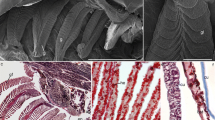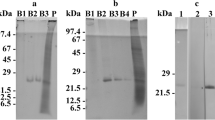Abstract
Polyclonal antibodies specific for the excitatory amino acid, kainic acid (KA), were raised in rabbits. The antibody recognized KA but did not cross-react with other structurally related amino acids, including glutamate. We used this anti-KA antibody to localize KA immunohistochemically in the KA-producing red alga Digenea simplex. KA immunoreactivity was most dense in the fine cylindrical thallus, which covers the middle to upper part of the alga. The cortical cells, but not the inner layers of the main axis, and cells of the rhizoid were also stained with this antibody. The presence of KA in cells that cover the surface of the alga might reflect its role in chemical defense. At the subcellular level, KA immunoreactivity was most intense in the nucleus, pit plugs, and the electron-dense areas denoted as “granule bodies”, which were found only in the pericentral cells of the thallus.











Similar content being viewed by others
References
Bellomo G, Vairetti M, Stivala L, Mirabelli F, Richelmi P, Orrenius S (1992) Demonstration of nuclear compartmentalization of glutathione in hepatocytes. Proc Natl Acad Sci USA 89:4412–4416
Calaf R, Barlatier A, Garcon D, Balansard G, Perlegrini M, Raynaud J (1989) Isolation of an unknown kainic peptide from the red alga Alsidium helminthocorton. J Appl Phycol 1:257–266
Dennison KL, Spalding EP (2000) Glutamate-gated calcium fluxes in Arabidopsis. Plant Physiol 124:1511–1514
Hofstetter O, Hofstetter H, Then D, Schurig V, Green BS (1997) Direct binding of low molecular weight haptens to ELISA plates. J Immunol Methods 210:89–92
Impellizezeri G, Mangiafico S, Oriente G, Piatelli M, Sciuto S, Fatorusso E, Magno S, Santacroce C, Sica D (1975) Amino acid and low-molecular-weight carbohydrates of some marine red algae. Phytochemistry 14:1549–1557
Kang J, Turano FJ (2003) The putative glutamate receptor 1.1 (AtGLR1.1) functions as a regulator of carbon and nitrogen metabolism in Arabidopsis thaliana. Proc Natl Acad Sci USA 100:6872–6877
Lam HM, Chiu J, Hsieh MH, Meisel L, Oliveira IC, Shin M, Coruzzi G (1998) Glutamate-receptor genes in plants. Nature 396:125–126
Laycook MV, deFreitas ASW, Wright JLC (1989) Glutamate agonists from marine algae. J Appl Phycol 1:113–122
Mione MC, Danevic C, Boardman P, Harris B, Parnavelas JG (1994) Lineage analysis reveals neurotransmitter (GABA or glutamate) but not calcium-binding protein homogeneity in clonally related cortical neurons. J Neurosci 14:107–123
Moffett JR, Namboodiri MA, Neale JH (1993) Enhanced carbodiimide fixation for immunohistochemistry: application to the comparative distributions of N-acetylaspartylglutamate and N-acetylaspartate immunoreactivities in rat brain. J Histochem Cytochem 41:559–570
Muramoto K, Kamiya H (1985) Analyses of dansyl and dabsyl amino acids by reverse-phase high-performance liquid chromatography. Bull Jap Soc Sci Fish 51:817–824
Ordronneau P, Abdullah LH, Petrusz P (1991) An efficient enzyme immunoassay for glutamate using glutaraldehyde coupling of the hapten to microtiter plates. J Immunol Methods 142:169–176
Pei-Gen X, Shan-Lin F (1986) Traditional antiparasitic drugs in China. Parasitol Today 2:353–355
Pszczolkowski MA, Zahand A, Bushman SM, Brown JJ (2003) Effects of calcium and glutamate receptor agonists on leaf consumption by lepidopteran neonates. Pharmacol Biochem Behav 74:389–394
Pueschel CM (1995) Cell structure In: Cole KM, Sheath R (eds) Biology of the red algae. Cambridge University Press, New York, pp 7–42
Sakai R, Swanson GT, Shimamoto K, Green T, Contractor A, Ghetti A, Tamura-Horikawa Y, Oiwa C, Kamiya H (2001) Pharmacological properties of the potent epileptogenic amino acid dysiherbaine, a novel glutamate receptor agonist isolated from the marine sponge Dysidea herbacea. J Pharmacol Exp Ther 296:650–658
Shinozaki H, Konishi S (1970) Actions of several anthelmintics and insecticides on rat cortical neurones. Brain Res 24:368–371
Shinozaki H, Ishida M, Okamoto T (1986) Acromelic acid, a novel excitatory amino acid from a poisonous mushroom: effects on the crayfish neuromuscular junction. Brain Res 399:395–398
Stuhmer T, Amar M, Harvey RJ, Bermudez I, Minnen J van, Darlison MG (1996) Structure and pharmacological properties of a molluscan glutamate-gated cation channel and its likely role in feeding behavior. J Neurosci 16:2869–2880
Takemoto T (1978) Isolation and structural identification of naturally occurring excitatory amino acids. In: McGeer EG (ed) Kainic acid as a tool in neurobiology. Raven, New York, pp 1–15
Wetherbee R (1979) “Transfer connections”: specialized pathway for nutrient translocation in a red alga? Science 204:858–859
Wright JLC (1998) Domoic acid-ten years after. Nat Toxins 6:91–92
Author information
Authors and Affiliations
Corresponding author
Additional information
This research was supported by Ministry of Education, Culture, Sports, Science and Technology to R.S. (13660206).
Rights and permissions
About this article
Cite this article
Sakai, R., Minato, S., Koike, K. et al. Cellular and subcellular localization of kainic acid in the marine red alga Digenea simplex . Cell Tissue Res 322, 491–502 (2005). https://doi.org/10.1007/s00441-005-0035-x
Received:
Accepted:
Published:
Issue Date:
DOI: https://doi.org/10.1007/s00441-005-0035-x




